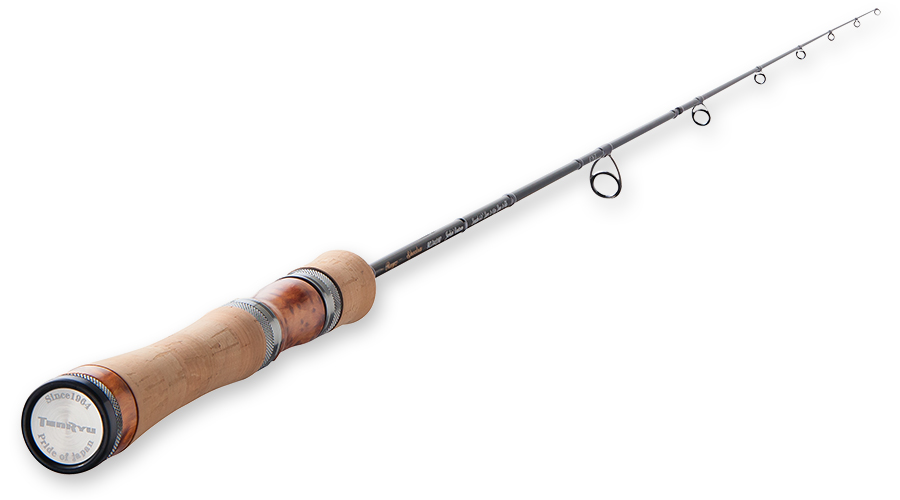JDM Spinning Rods
Spin fishing for trout in Japan is divided into "Native" (also called wild or natural) fishing in mountain streams and "Area" fishing (stocked, managed trout ponds). Some Areas are on streams, but the streams are a series of man-made pools constructed by building rock dams across the stream at intervals. Fishing the pools is essentially the same as fishing in a lake - no obstructions and minimal current.
 There will be a gap between the sections.
There will be a gap between the sections.For all the rods, though, there will be a gap between the sections. It is supposed to be like that. Please don't try to force the sections together.
JDM Spinning Rods for Native Trout
The rods used in Japan for fishing in streams are firmer and more tip flex than the Area rods. Even though the fish that are caught in Japanese streams are almost always much smaller than those caught in Areas, anglers have to deal with the current, which is often swift in the high-gradient mountain streams. Also, keeping fish out of snags is a concern in wild streams but not in managed trout ponds.
The lures also tend to be different. Many anglers use micro spoons in the Areas and "minnow" lures in streams. The minnow lures look similar to the familiar Rapala, but they are primarily heavy, sinking minnows weighing 4.5 grams, a bit over 1/8 oz. Although spinners are extremely popular in the US, they are not popular in Japan. They do exist, but they aren't very popular.
I learned from talking to Japanese anglers that they feel catching trout with spinners is too easy. They impart action to their minnow lures, and learning what the fish want that day with respect to the strength and frequency for the rod tip twitches and jerks is seen as a challenge that makes trout fishing more interesting. I truly believe they would prefer to catch ten hard won trout than ten times that many if they came too easily.
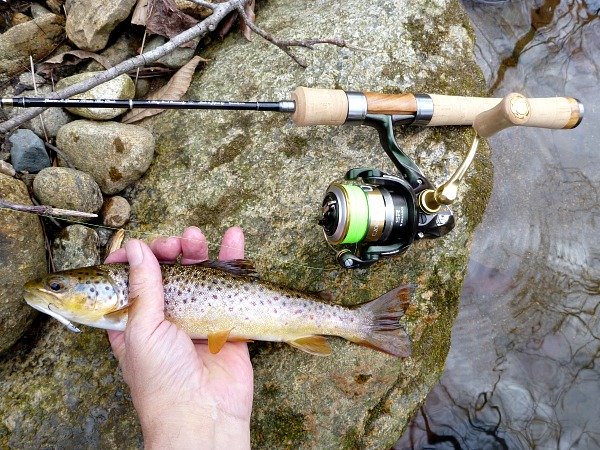 Tenryu Rayz RZ53UL with Shimano Cardiff CI4+ C2000HGS
Tenryu Rayz RZ53UL with Shimano Cardiff CI4+ C2000HGS(both since discontinued)
Whether you prefer spinners, spoons or plugs, though, the JDM spinning rods for wild or native trout would be a better choice than the Area rods for stream fishing here in the US. Stream anglers here face the same challenges with current and snags as the Japanese anglers do, plus one significant challenge that most Japanese anglers do not face - the possibility for big fish!
There is one notable exception, though, and that is when fishing a relatively small, relatively gentle stream for smaller fish. One of my favorite streams is pretty low gradient, and nearly all of the fish are in the 5 to 7" range. Smaller lures, such as the 1.5 gram Shimano Slim Swimmer spoons or the 2 gram Smith AR-S spinners are very effective at catching them, and an Area rod does very nicely with the smaller lures and smaller fish.
The best stream spin fisherman I know of is Frank Nale, who lives in south-central PA. He regularly catches wild trout over 16" - which for most anglers in Japan would be the catch of a lifetime. Granted, he doesn't catch fish that size on every outing - or even every other outing, but nearly every outing at least offers the opportunity for a large fish. An Area rod can certainly tame a 16" fish in a lake with few obstructions, but in a river with current, not to mention rocks and logs, the firmer backbone of a native trout rod would be much better - for hook sets as well as controlling and then netting the fish.
The nicest spinning rods for trout that I have ever seen are the Tenryu Rayz series of rods. The top of the line is the Spectra, which is what I call a "Wow" rod (everyone who picks it up says "wow" - seriously). In addition to the Tenryu Rayz Spectra RZS51LL, I currently stock several Tenryu Rayz spinning rods designed for wild trout.
The RZ4102S-UL was designed specifically for fishing wild trout streams in Japan - and will be just as much at home on small to medium sized streams here in the US. The RZ4102S-UL is designed for light lures and light lines (up to 6 gram, about 3/16 oz lures and 1 - 4 lb lines).
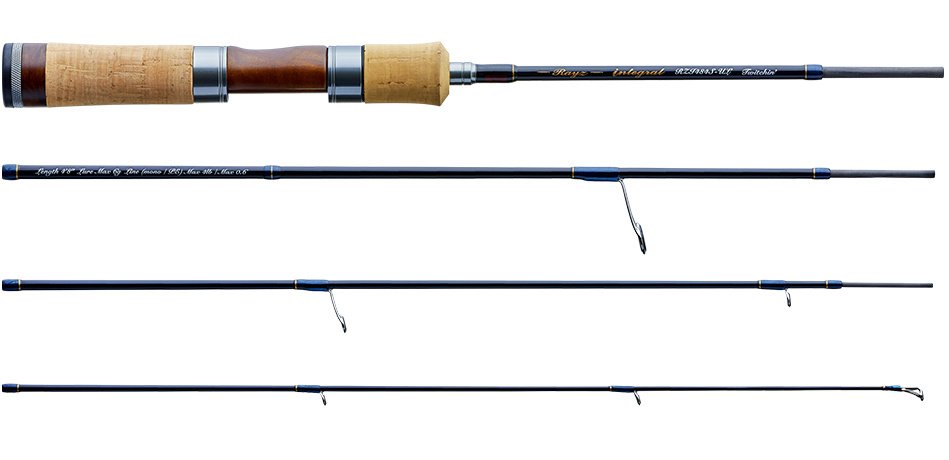 Tenryu Rayz Integral RZI48UL-4
Tenryu Rayz Integral RZI48UL-4New in 2023
The Tenryu Rayz Integral RZI48UL-4 is a four-piece "travel" rods. I call it a four-piece "convenient" rods! One of the things I have definitely gotten used to with my tenkara fishing over the past ten plus years is the extreme convenience of having a rod that collapses to about 20" or less. You can carry it very easily strapped to a backpack, and some collapse down to a length that will fit completely inside even a modest day pack. The Tenryu Rayz Integral 4-piece rods break down to just under 16"! They will fit inside a backpack (and in your carry-on bag)!
For some reason that I do not understand, people seem to have a bias against multi-piece rods. Fifty years ago, when rods were glass and ferrules were metal, that feeling made sense. Now? Not so much. Technology has moved on and modern multi-piece rods are excellent. I guess my feeling on that also comes from fishing with tenkara rods, which often have 8 or 9 sections, and keiryu rods which may have 13 sections or more. They cast just fine. They fight fish just fine. It is the same with the Tenryu Rayz Integral 4-piece rods - they are wonderful rods that cast and fish just fine. And they are so much more convenient than even a 2-piece rod that if you try one you may never go back.
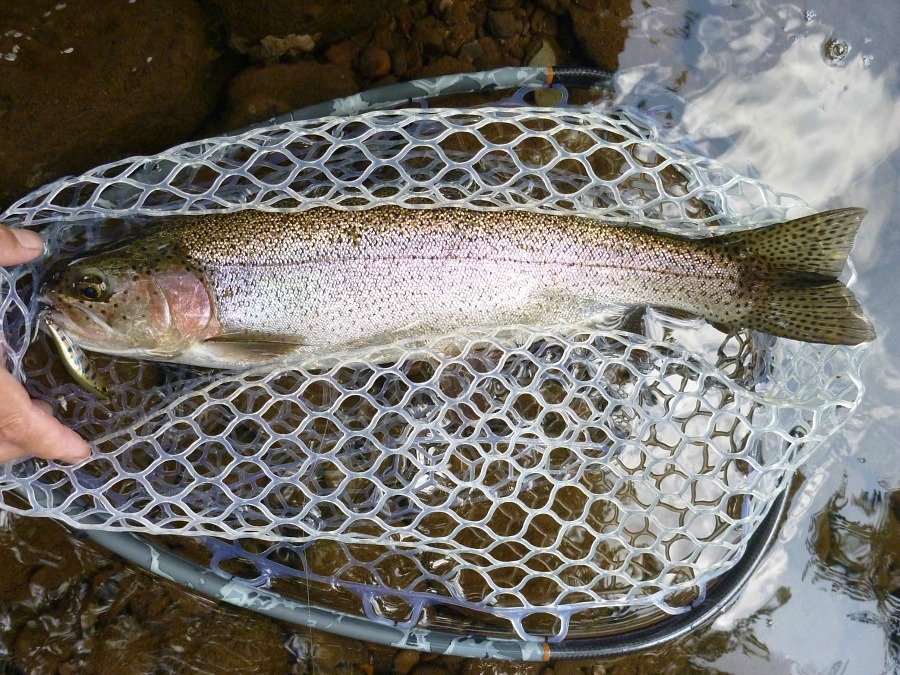 Nice rainbow trout caught with a "heavy sinking minnow."
Nice rainbow trout caught with a "heavy sinking minnow."Many of the JDM spinning rods designed for stream fishing are short, often around 5'. When fishing smaller streams, a shorter rod is easier to maneuver and easier to cast accurately. While there are a few Area spinning rods under 6' in length, most are about 6' and do not have the the backbone to keep a fish away from logs and branches and the ability to work the heavy sinking minnows that Japanese stream anglers prefer.
The JDM trout rods definitely are not "all around" or "one-size-fits-all" rods. They are designed for a specific purpose - but for that purpose they are wonderful.
JDM Spinning Rods for Area Trout
"Areas" are pay-to-fish
stocked trout ponds. There are a few of those in the US as well, but
they aren't that popular. In Japan, where there are lots of anglers and
not a lot of places to fish, they are quite popular and fishing pressure is intense. Some Areas also have stocked streams, but ponds are much more common.
Just as bass anglers' need for greater finesse gave rise to the Bait Finesse System, Area trout anglers' need for lighter lures and lighter lines has given rise to Area trout rods. They have a more progressive bend, in part for casting the light lures but even more for protecting the hair-thin lines. The rods and reels are rated for lines down to 1 lb and lures down to .4 gram - less than 1/64th ounce.
Although pay-to-fish trout ponds are not popular here, there are thousands of lakes that hold trout, and the Area rods are perfectly suited for them. For that matter, there must be hundreds of thousands of ponds and lakes that hold sunfish and crappies, and the Area rods are perfectly suited for them, too! And if you happen to hook a bass? If you are fishing open water, the rod will do its job and tire the fish. I've caught lots of smallies in Maine on 2 lb line. However, if you are fishing with a soft Area rod and very light line around heavy cover, all I can say is I wouldn't use expensive lures.
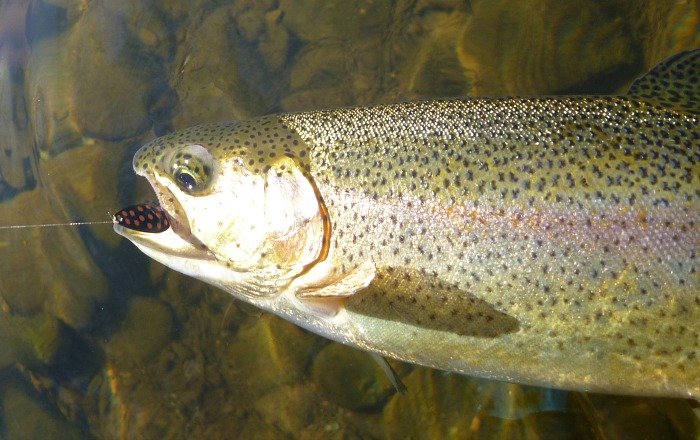 JDM micro spoon and rainbow trout
JDM micro spoon and rainbow troutThere is another reason for the difference in Native and Area rods. In Japan, the most popular lure for native trout is a sinking minnow lure. The most popular lure for fishing in areas is a micro spoon. A rod designed for twitching a heavy sinking minnow needs to be firmer, and have a firmer tip in particular than a rod designed for fishing a micro spoon with a steady retrieve.
I have seen a couple YouTube
videos of a Japanese angler fishing a mountain stream with a rod designed for Areas, using a micro spoon
and a Smith AR-S spinner, both of which also were designed for Areas.
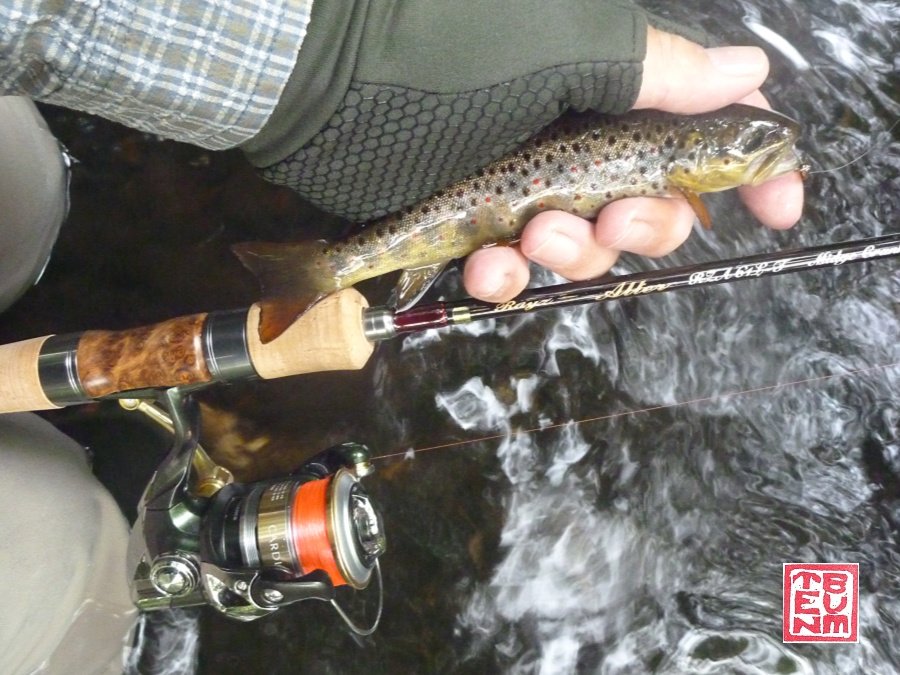 Tenryu Rayz Alter
Tenryu Rayz AlterI have tried it myself with a Tenryu Rayz Alter (Trip Report 9-2-19). An Area rod is perfectly capable of fishing micro spoons and small spinners in mountain streams. If the fish are not too large and the current not too fast, an Area rod is not only extremely effective, it's a lot of fun.
I have been a bit surprised at how micro fishing has taken off in the US. Most people who are getting into micro fishing use spinning rods rather than dedicated micro fishing rods like the rods used for tanago fishing in Japan.
Even ultra light spinning rods are overkill for really small fish. Still, small fish are in almost every body of water. You don't have to book a trip to Patagonia to find them. With the right gear (a very light, very sensitive rod) even the chubs and shiners in the little creeks that no one ever fishes can be a lot of fun.
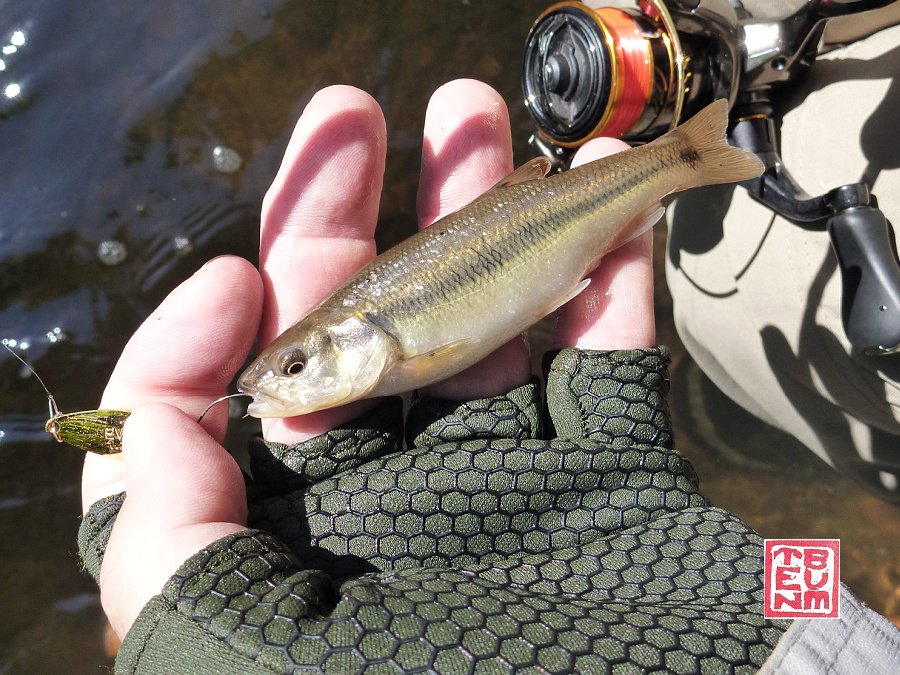 Creek chub caught with a micro spoon (which an Area rod can cast).
Creek chub caught with a micro spoon (which an Area rod can cast).Ajing and Mebaru Rods
Ajing and Mebaru rods are designed for ultralight salt water fishing. Although most anglers in the US wouldn't think that "ultralight" and "salt water" even belong in the same sentence, it is quite popular in Japan.
Aji are what we would call horse mackerel, and Mebaru are fairly modest sized sea bass. The fish are different, so the rods are different.
Aji are open water fish and are constantly swimming. If a school happens to be swimming towards you and comes up on your lure from behind, it is very likely that one will take it and keep swimming towards you. That is a very hard bite to detect, so ajing rods are extremely sensitive. They are relatively stiff rods (to be sensitive) with soft tips (to protect a very light line).
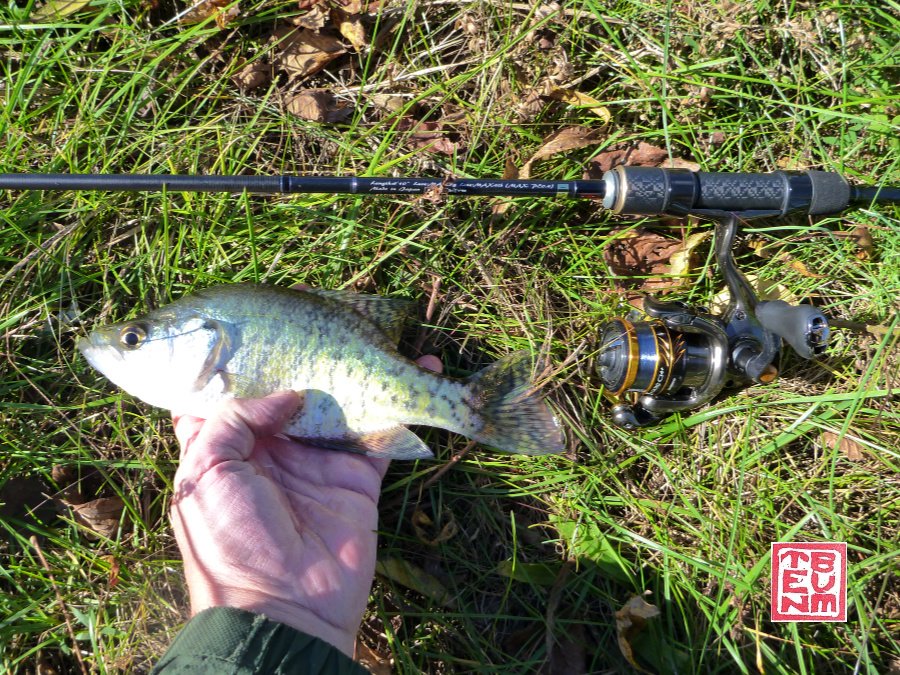 Lunakia LK6102S
Lunakia LK6102SAjing rods are popular in the US, but not for mackerel fishing! They are used primarily for sunfish, fished with light jigs and small plastics. The same ajing jig heads and plastics used in Japan for aji work very nicely here for sunfish.
Mebaru live around the rocks on the bottom. The rods used to catch them are softer and more mid flex than the ajing rods. Mebaru are not large, and the lines used to catch them are light. People here in the US use mebaru rods primarily for crappie fishing. The softer rod is a better choice for crappie as it is less likely to rip the hook out of the crappie's tender mouth.
The Tenryu Lunakia LK6102S-MLT was designed to work well for both aji and mebaru. It is a bit softer and not quite as fast as an ajing rod, and just a bit stiffer and faster than a mebaru rod. If you want one rod for crappies and sunfish (and smallmouth, and white bass and, ... and ...) it would be a good choice. The shorter Lunakia LK632S-LMLS is an ajing rod (and a lot of fun with sunfish).
Home > Finesse Spin Fishing > JDM Spinning Rods
Header photo: Tenryu Rayz RZ4102B-UL, Shimano Calcutta Conquest BFS-HG ('17)
Warning:
The hooks are sharp.
The coffee's hot.
The fish are slippery when wet.
Seriously, all the hooks sold on Finesse-Fishing.com, whether packaged as loose hooks or attached to lures, are dangerously sharp. Some have barbs, which make removal from skin, eyes or clothing difficult. Wear eye protection. Wear a broad-brimmed hat. If you fish with or around children, bend down all hook barbs and make sure the children wear eye protection and broad-brimmed hats. Be aware of your back cast so no one gets hooked.
Also, all the rods sold on Finesse-Fishing.com will conduct electricity. Do not, under any circumstances, fish during a thunder storm. Consider any fishing rod to be a lightning rod! Fishing rods can and do get hit by lightning!
Whatever you do, do it with finesse!
